
This story is a part of “A Year in the Wild Kitchen of the Great Lakes,” a series in partnership with expert forager Lisa M. Rose, with the mission of nurturing a deeper connection with the natural world through foraging. To get started with your foraging journey, begin here with our “Framework to Sustainable and Safe Practices.”
High summer brings an explosion of wild herbs and edible flowers like elderflower, Queen Anne’s lace, monarda, and chicory. Discover where to find and forage these delightful, edible plants and how these can add extraordinary flavors and colors to your summer dishes.
Elder (Sambucus nigra)
Edible Parts: Berries, flowers
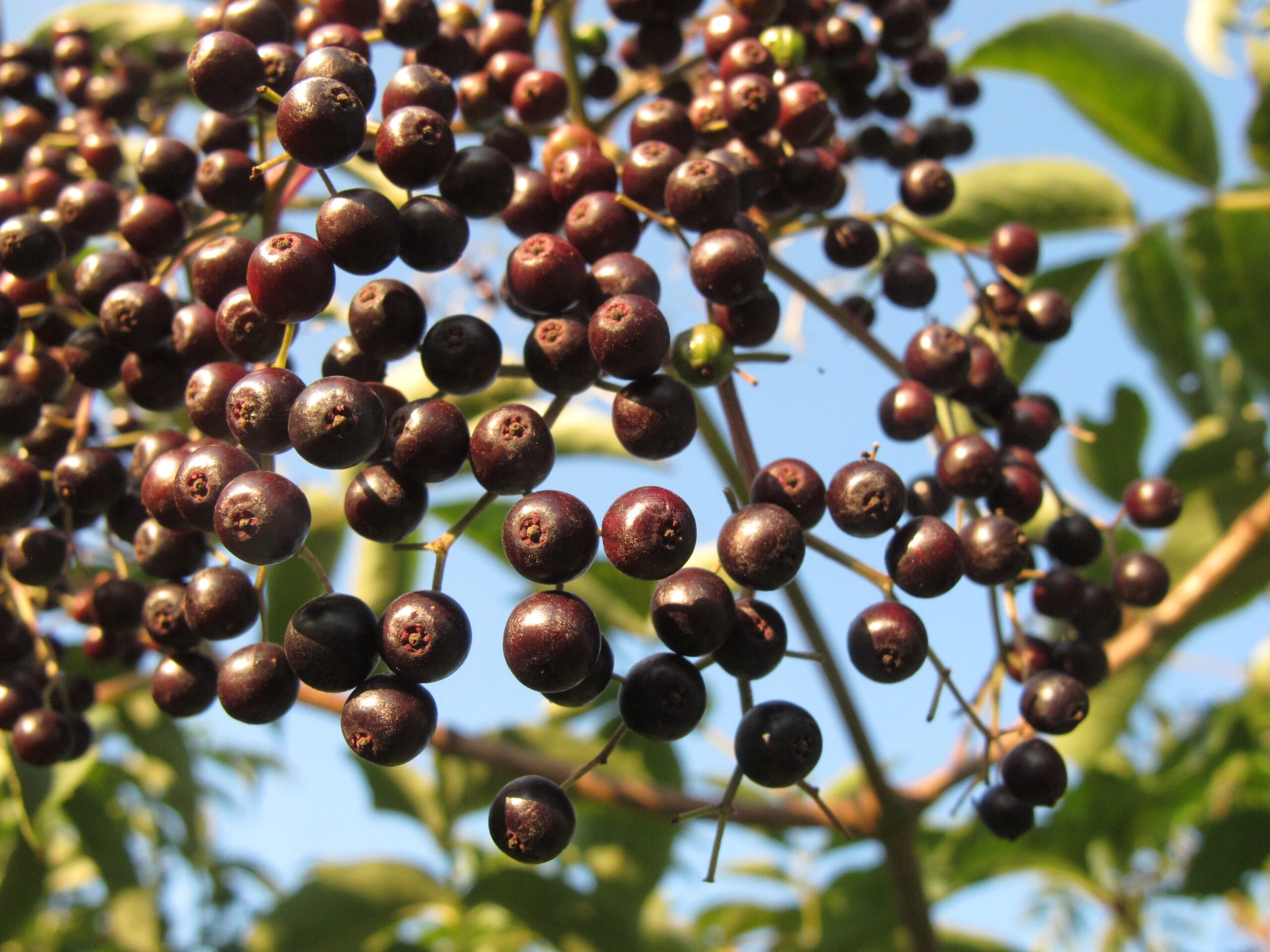
Elderberries hang as heavy umbels of fruit in mid-August. (Photo Credit: Lisa M. Rose)
From lightly scented cordials and pound cakes made with elderflowers to yummy jam made from its dark and delicious berries — you will find harvesting, preparing, and enjoying the flowers and fruits of the elder to be a delightful high-summer experience.
Elderflowers and berries can be used as food and valuable herbal medicines. The elderflower has a fragrant, dusty odor and pairs delightfully with honey. Consider infusing honey with elderflowers or making a simple syrup for the bar using honey in lieu of cane sugar.
The flavor of the elderflower is light and works well with other light flavors, especially citrus. Jams, fruit leather and shrubs are all ways to use the small but sweet and tasty dark berry. Remove the seed using a sieve for projects like jam or fruit leather.
The berry can also be made into a simple syrup filled with antioxidants; use it in cocktails, or as a base for the traditional vinegar and honey shrub (or oxymel). Either dry or fresh elderflower can make a delightful tea that performs as a relaxant.
How to Identify: Elder is a large shrub that begins bearing clusters of fruit when it is approximately 5 feet tall. Its bark is light gray with bumps, and its wood is brittle, unsuitable for building. Branches are hollow and filled with pith. Elder’s leaves are opposite and compound, with five to seven leaflets that are smooth, lance-shaped, toothed, and between 2 and 6 inches long.
Around midsummer, the white fragrant flowers unfold in terminal clusters on showy umbels. In a normal summer, the deep purple and black berries ripen in mid-to-late August and hang heavy from the umbels in the bush.
Where and when to gather: Elder grows in hedgerows, along edges of fields, and in drainage ditches or other low-lying areas where water flows. The first of the elder’s flowers open after solstice, and blooms continue through mid-July. The berries appear in mid-August and are quickly eaten up by the birds.
Monarda (Monarda fistulosa)
Edible Parts: Flowers, leaves, stems

Monarda in bloom in the high noon sun. (Photo Credit: Lisa M. Rose)
Not only should corn be knee high by the 4th of July, but the fiery pink blossoms of monarda open up right in the height of the summer sun. It is a spicy and aromatic herb similar to oregano and can be used similarly in cooking.
As a culinary spice, monarda can be included in recipes calling for Italian seasoning combinations, such as pizzas, pasta sauces, and chili. Infusing this spicy herb into olive oil can result in a versatile aromatic oil that can be used as a dipping oil for bread and as a base for salad dressings.
Monarda can be infused into cold water for a refreshing summer iced tea. When it’s prepared as a warming tea, the spicy aromatics can dispel the damp chill of a rainy day and stimulate circulation in cold hands and feet. Monarda leaves and flowers can be extracted in raw, local honey then served on toast or as a complement to a platter of fresh, local goat cheeses and bries. The honey can flavor meringues, cake icings, tea cakes, and other baked goods.
How to identify: Monarda fistulosa is a perennial native plant from the mint family. Typically 24 to 36 inches tall, it grows in patches in sunny open fields and prairies. The stem is square, and the leaves are opposite each other and slightly toothed and hairy. The blooms of monarda are showy, with individual pink blossoms radiating from the center seed head.
Where and when to gather: The fresh spring leaves and stems of monarda can be gathered anytime and used in the kitchen, fresh or dried. The summer’s blossoms can be gathered and used until they become dry in the fall.
How to gather: In summer, the full stems and flower heads can be gathered, bundled and dried for tea in the winter. Store all fully dried plant material in airtight containers to preserve the aromatics.
Chicory (Cichorium intybus)
Edible parts: Leaves, roots
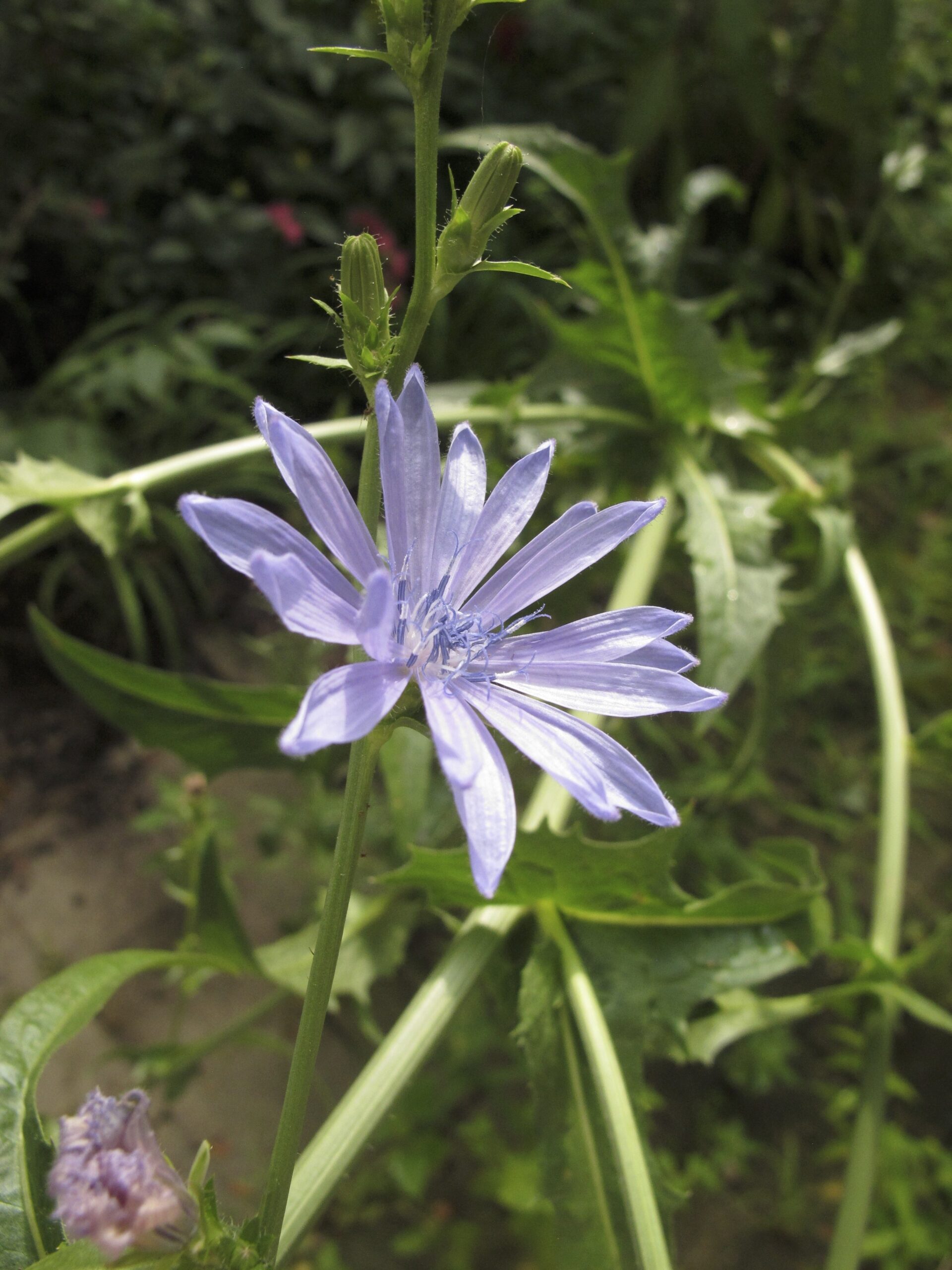
Chicory flowers in bloom in midsummer. (Photo Credit: Lisa M. Rose)
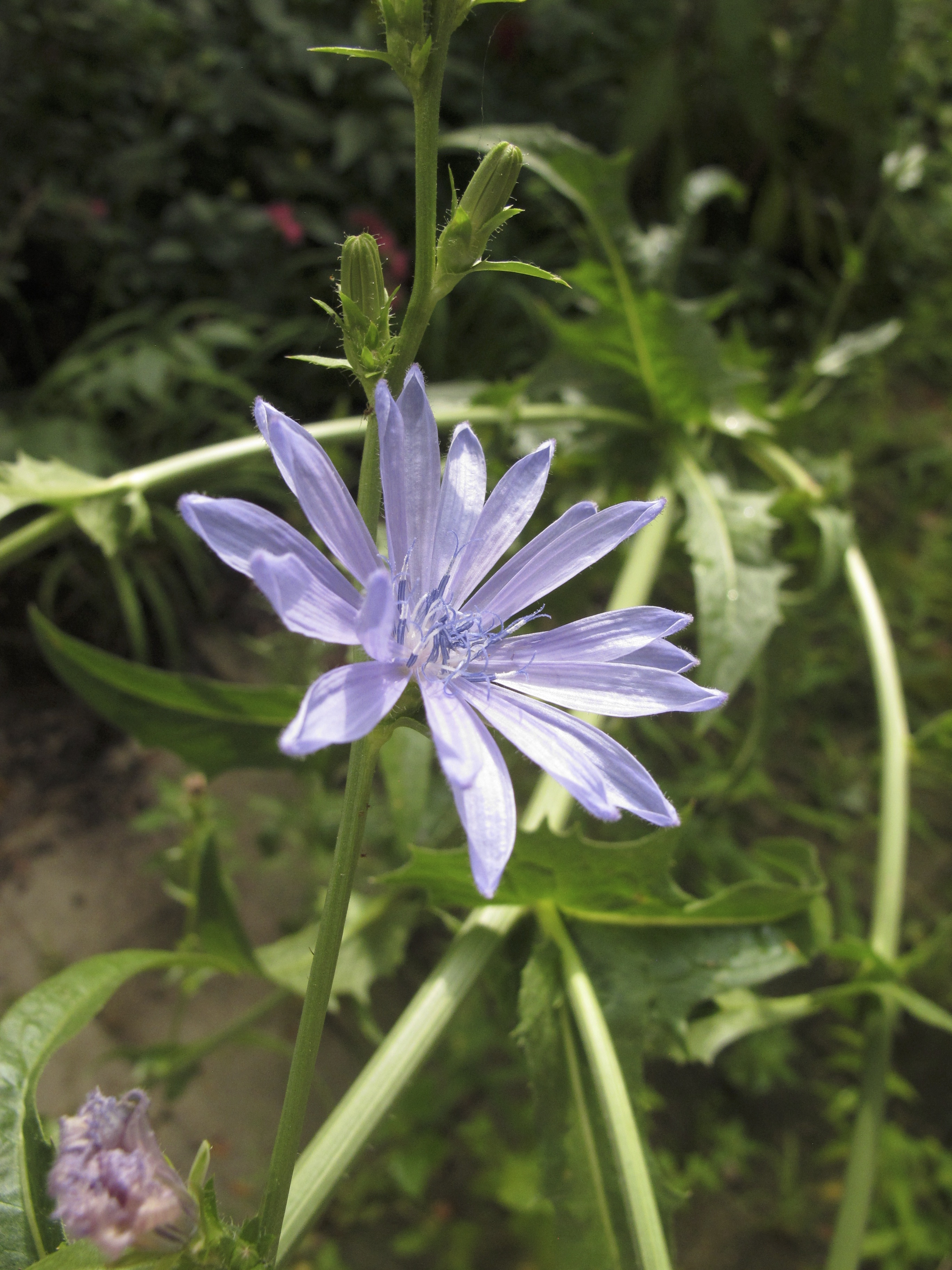
The tender spring leaves can be gathered and eaten in salads along with other early spring greens. The leaves of the mature chicory also remain edible, though by midsummer they are significantly more tough, dry and bitter than the tender leaves of spring. These larger leaves can be stir-fried with other greens or eaten fresh when massaged with a nice mustard vinaigrette.
Chicory root is a bit rough and spindly to be used as a roasted or cooked root vegetable, but it can be harvested, dried and roasted to make a tea. Chicory is a great addition to a foraged herbal chai tea, blended with the likes of dandelion root, burdock root, sassafras root, chaga mushroom, spicebush berry, and black tea. Roasted chicory root tea has a pleasant earthy flavor and certainly can stand on its own as a unique beverage.
How to identify: Chicory is widespread across the Midwest. In early spring, the perennial chicory is a basal rosette of long, pinnately lobed leaves with a large midrib vein. In the height of summer, the mature flowering chicory can tower well over 6 feet.
Its sprawling stalks extend wildly in every direction, decorated with beautiful blue flowers. The flat-tipped flowers range in color from cornflower blue to translucent blue-purple and range from 1/2 inch to 2 inches across. The long, whitish taproot is similar to that of dandelion, and the root and stem contain a milky sap.
Where and when to gather: Chicory is found in open fields, empty lots and along roadways. It frequently is interspersed with dandelion, dock and Queen Anne’s lace. In the early spring, you want to harvest the tender leaves for salads. In later summer and into fall, gather the larger leaves and roots. As chicory likes rocky, gravelly and dry soil it is sometimes difficult to remove the root in its entirety.
How to gather: Harvest in the early morning when the leaves are more sweet than bitter, and choose to gather smaller leaves. To gather roots in the fall, choose a spot in soil that is less rocky and damp to make harvesting easier. Clean, chop and dry the root in a dehydrator, then store it in an airtight container for later use.
Wild Carrot (Daucus carota)
Edible Parts: Leaves, roots, seeds

Umbels of wild carrot are distinguishable by feathery, deeply cut first-year leaves with small vertical hairs, and a second-year plant with a thin, hairy stem up to 4 feet tall. The wild carrot smells undeniably like its grocery-store counterpart. (Photo Credit: Lisa M. Rose)
Wild carrot, also known as Queen Anne’s lace, graces summer grasslands with its delicate appearance. Its roots, leaves and seeds bring a subtle carrot flavor to dishes. The roots are smaller and nuttier than cultivated carrots but can be tough when raw.
Boil and mash young roots by combining them with other roots from the grocer — this adds some “forager flair.” Fresh leaves of the wild carrot can add a herby carrot flavor to salads, while umbels can be used in fritters. Seeds will flavor soups and stews but should be crushed first due to their texture.
How to identify: Wild carrot is a petite biennial plant in the Apiaceae family, which includes the poisonous look-alike poison hemlock (Conium maculatum). Key identifiers include feathery, deeply cut first-year leaves with small vertical hairs and a second-year plant with a thin, hairy stem up to 4 feet tall.
Wild carrot blooms in late July and August with wide, flat, white umbels, sometimes featuring a dark purple flower in the center. The entire plant smells distinctly of carrots. The absence of this smell may indicate a different, potentially poisonous plant. Handle plants in the Apiaceae family with gloves, as toxins from poison hemlock and water hemlock can be absorbed through the skin.
Where and when to gather: Wild carrot is common across the Midwest, thriving in disturbed areas, along roads and in open fields. Roots and leaves can be harvested in early summer, with seeds ripening in late summer.
How to gather: When harvesting in dry or rocky soil, use a digging fork to avoid breaking the root. Target first-year plants for less woody roots. Harvest leaves carefully to avoid sand. Gather umbels in the morning when they are bug-free and clean. Collect seeds when they are dry and brown before fall rains reduce their flavor.
Caution: Always confirm the distinctive carrot smell before consuming, and wear gloves when handling to avoid the risk of poison hemlock and water hemlock exposure.
Elderflower Cordial Recipe
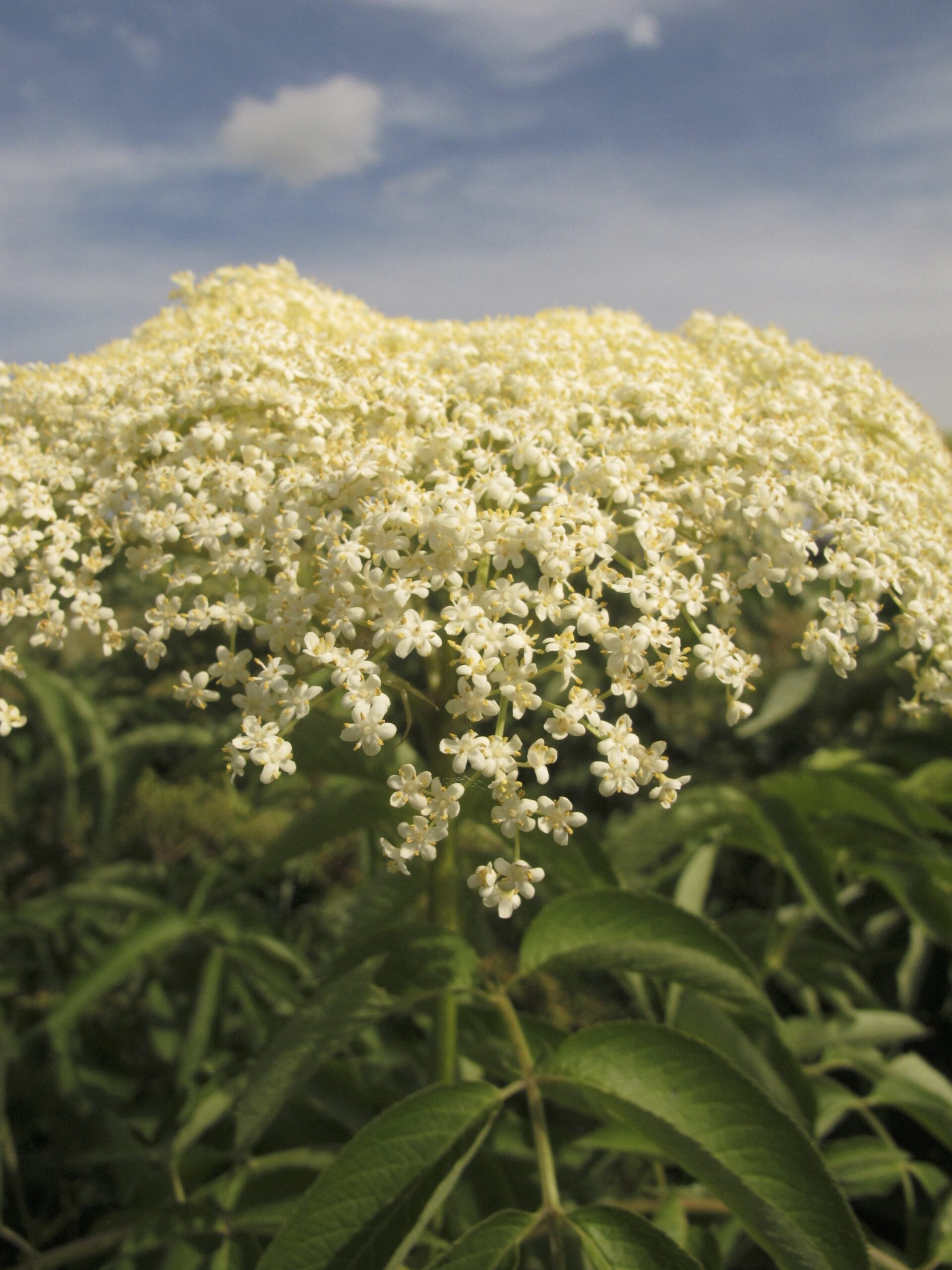
Fresh elderflower to be gathered in early July. (Photo Credit: Lisa M. Rose)
Capture the essence of summer with this refreshing elderflower cordial. Made from fragrant elderflowers, fresh lemons and a touch of sugar — this delightful drink is perfect for warm days. Whether enjoyed on its own, mixed into cocktails or drizzled over desserts this homemade cordial brings a burst of foraged floral sweetness to any occasion.
Ingredients:
- 20 elderflower heads (ensure they are freshly picked and free from insects)
- 8 1/2 cups water
- 3 1/3 pounds granulated sugar
- 4 lemons (preferably organic)
- 1.8 ounces citric acid (optional for preservation and added tartness)
Instructions:
- Prepare the elderflowers:
- Gently shake the elderflower heads to remove any insects, remove any dust or debris.
- Remove all the thick stalks, keeping only the flowers and small stems.
- Prepare the lemons:
- Wash the lemons thoroughly.
- Using a vegetable peeler, remove the zest of the lemons, being careful to avoid the white pith.
- Slice the lemons thinly after zesting.
- Make the sugar syrup:
- In a large saucepan, bring the water to a boil.
- Add the sugar and stir until completely dissolved.
- Remove from heat once the sugar is dissolved.
- Combine ingredients:
- In a large heatproof bowl, combine the elderflowers, lemon zest, lemon slices, and citric acid (if using).
- Pour the hot sugar syrup over the elderflowers and lemon mixture.
- Stir well to ensure all the flowers and lemons are submerged.
- Infuse:
- Cover the bowl with a clean cloth or plastic wrap.
- Let the mixture infuse for 24-48 hours in a cool, dark place. Stir occasionally.
- Strain and Bottle:
- After infusing, strain the mixture through a fine mesh sieve or muslin cloth into a clean jug.
- Pour the strained cordial into sterilized bottles using a funnel.
- Seal the bottles tightly.
Serving Suggestions:
- Diluted with Water: Mix with still or sparkling water for a refreshing drink.
- In Cocktails: Use as a mixer in gin or vodka-based cocktails.
- With Desserts: Drizzle over cakes or ice cream for a floral twist.
Storage:
- Store the elderflower cordial in a cool, dark place. Refrigerate after opening.
- If you added citric acid, then the cordial can last for several months unopened. If not, it’s best consumed within a few weeks.
Enjoy your homemade elderflower cordial, capturing the essence of wild Michigan summer in every sip!
About the Author
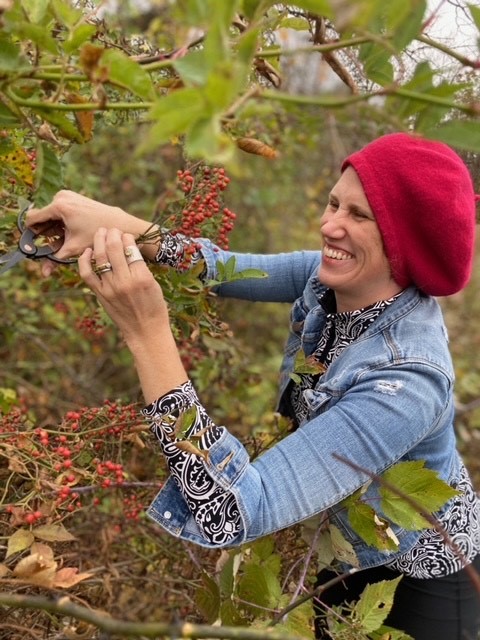
Lisa M. Rose is an ethnobotanist, wild foods chef, and author with a profound dedication to exploring the symbiotic relationship between humans and plants. With an academic background in anthropology and community health, her culinary journey has been rich and varied, including stints with notable establishments and figures such as Stags Leap in Napa Valley, Alice Waters’ The Edible Schoolyard, and organic farmers in Northern Michigan.
Rose’s work is celebrated in her bestselling books, “Midwest Foraging” and “Midwest Medicinal Plants,” among others and her expertise is frequently sought by major media outlets, including the Chicago Tribune, PBS, NPR, Martha Stewart and CNN.
Catch more news at Great Lakes Now:
Wild Berry Bonanza: Juicy Jewels of the Great Lakes Summer
Cornish Roots & Nettle Shoots: A Foraged Pasty Recipe from Michigan’s Upper Peninsula
Featured image: Gathering elderflower for cordials and tea. (Photo Credit: Seth D. Starner)




